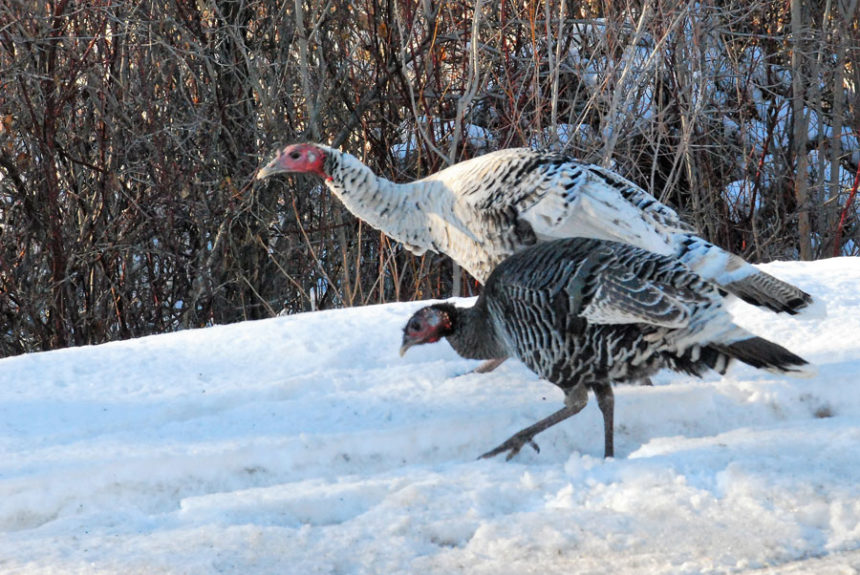Living the Wild Life is brought to you by The Healing Sanctuary.
“I’ve got a ton of turkeys down by my place,” commented a friend of mine, last Sunday at church. “There is a lot more than I saw last year and I had about 60 at the starts of the winter.”
My friend and I have a stubble field and a hay field between us and on Wednesday I heard a lot of gobbling while I was shoveling snow. I got my camera and binocs and counted 102 turkeys in three groups in the stubble field, chasing each other and eating late volunteer grains. I watched as they made their way to the Teton River bottoms where they like to roost high in the cottonwoods for the night.
Now that the snow is getting deeper, several flocks appear to be getting together as they dig through the snow for something to eat. The females lead the groups to the food while the toms chase each other around as much as they hunt for food. Boys will be boys, no matter their age.
The flocks along the South Fork of the Teton River are not the only abundant flocks as there are a lot of turkeys along the South Fork of the Snake River near Heise to the confluence with the Henrys Fork. The Henrys Fork from the Chester area through the Plano and Burton areas contain both large and small flocks. As the winter progresses, these groups may join as they are forced to dig under hawthorn and chokecherry bushes to find enough food to survive.A flock of toms (males) arguing about something as they find some brunch in a field. | Bill Schiess, EastIdahoNews.com
Many of these flocks will gravitate to the roads where the snowplows scrape the edge of the barrow-pits, exposing grass and weeds for them to feed on. When you see turkeys along the side of the road, slow down, a 20-pound butterball coming through your windshield cannot be a joyful experience.
Wild turkeys are not native to Idaho but were introduced in northern Idaho starting in 1961 by the Idaho Fish and Game Department. In the late 1980s and early 1990s some were transplanted into the Upper Snake River Valley along the South Fork of the Snake River. Northern Idaho has the largest population of them in the state, but from the recent large flocks southern Idaho may be catching up.Two hens roosting on an irrigation wheel line. | Bill Schiess, EastIdahoNews.com
As their population grows, the conflict between homeowners and bird will also grow. They can become very aggressive when they get hungry. You do not want to feed them near your home as they can make quite a mess; I cannot imagine what a mess 102 turkeys could leave on my driveway. A couple of years ago, seven of them discovered my bird feeders and began cleaning up under them. It was not long before they would jump/fly up to knock out the feed to get more. I finally drove them away by shooting my shotgun when I saw them coming in from the river bottoms.
From their coloring and they appear to have hybridized between their subspecies. Merriams were introduced first followed by the Rio Grande and eastern subspecies. Some of the birds in the Chester and the Ririe areas appear to have crossed with some domestic birds because of their white and black feathering and their diluted brown coloring.A turkey takes to the air as it flies about a half mile to the river bottoms. | Bill Schiess, EastIdahoNews.com
It is fun to watch them from a distance and so far I have been able to control where they feed with a shotgun blast each morning. My wife does not like the big deposits they made on my yard when they have visited.
A couple of other things to watch may be the pheasants that are survivors from the stocking done for hunting. Beaver Dick Park, Mud Lake and Market Lake Wildlife Management Areas have some of these birds feeding under the berry bushes. Also, the ice is starting to form near the dam on Ririe Reservoir meaning ice fishing there will soon begin. Be careful as several people went through the ice during the early freeze-up last year. Make sure it is safe before heading out to chase the kokanee.
Have a great Christmas season – enjoy family and friends, but stay safe and be careful of the big birds.A turkey flying up into a cottonwood to roost for the night. | Bill Schiess, EastIdahoNews.comPart of a flock of over 100 wild turkeys gleaning grains from a stubble field near Rexburg.| Bill Schiess, EastIdahoNews.com
Source : EastIdahoNews







